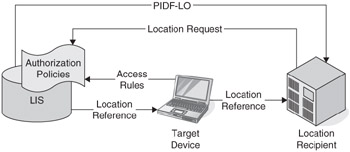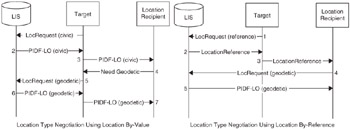Chapter 4: The LIS, Location Acquisition, and the HELD Protocol
The previous chapter dealt with the aspects of taking and providing network measurements inside the access network. It described the abstraction of the ALE and its role in taking network measurements and passing them to the Location Information Server (LIS) using FLAP. In this chapter, we examine the LIS in more detail. We describe the various LIS interfaces, the different types of LIS, and we discuss in some detail the HELD protocol and how it accommodates the location acquisition needs of various types of users.
The Location Information Server
The Location Information Server (LIS) combines the functions of location determination and location distribution. The IETF GEOPRIV location architecture described in Reference 1, at the end of the chapter, describes two key functions, location determination performed by a location generator (LG), and location distribution performed by a location server (LS). These same two functions occur in the NENA-i2 and -i3 architectures but are combined into a single server called the LIS. Figure 4.1 shows how these two architectural views come together. For the remainder of this chapter, we shall restrict our terminology of this functionality to the term LIS.

Figure 4.1: LIS to GEOPRIV mapping.
The Location Information Server (LIS) is at the heart of the IP location architecture, and has the following key responsibilities:
-
Determining the location of an IP device inside its domain
-
Delivering location information to a Location Recipient
-
Asserting that the location provided by an IP device inside its domain is reasonable
-
Ensuring location dependability
-
Protecting the privacy of the Target to which the location is attributed
While a LIS may implement all of these functions, it is not required for it to do so. A LIS is categorized according to which of these functions it can perform (the various LIS types are described in later sections of this chapter).
The LIS determines the location of devices in the network through the use of network measurements that it obtains from ALEs distributed throughout the access network. ALEs were described in detail in Chapter 3. The ALE measurements and their use in location determination are access technology-specific.
The LIS provides a common access interface for obtaining location information that hides the access-specific aspects of the network, ensuring that location can be requested in the same manner regardless of the access medium. So the LIS looks and behaves like any other Internet-based service from a user's perspective.
The location of a device needs to be treated with a degree of confidentiality, and must not be handed out to just any requesting party. Location must only be made available to requesting parties that satisfy strict authentication and authorization policies. How authentication and authorization policies are enforced is a matter of application, and is strongly dependent on the network configuration and the intended use. Public access networks will likely demand very strong applications of these policies to protect against fraud and maintain the privacy of the network's users. Private networks have more flexibility as to the level of authentication and authorization they require before making location information available. The application of these policies is discussed in Chapter 10.
Location Distribution to the Target
One of the primary roles of the LIS is distributing location information to the Target. This can occur in one of two ways: as a literal location and/or as a location reference. A literal location is the actual location of the Target at the time of the request, and is distributed in the form of a PIDF-LO. This is also referred to as location by-value in the common vernacular. A location reference is, as the name suggests, a reference or pointer to a place from which a literal location can be retrieved. The differences were described briefly in Chapter 2, but will be reiterated and described in more detail here as they are important to the operation of a LIS and form key functionality provided by HELD.
Location By-Value
The location by-value model centers on the premise that the Target is also the owner and safe-keeper of its own location. The Target retrieves a literal location (PIDF-LO) from the LIS and decides when, and to whom, to provide it (see Figure 4.2).

Figure 4.2: The location by-value model.
Location By-Reference
Location by-reference requires the Target to employ a LIS to manage the dissemination of its location to authorized Location Recipients (see Figure 4.3). The Target requests a location reference from the LIS, which it subsequently makes available to would-be Location Recipients. Location Recipients wishing to know the location of the Target can use the location reference to retrieve the Target's location from the LIS. Unauthorized access to the Target's location is secured by the Target providing a set of access rules to the LIS, and the LIS requiring all querying nodes to satisfy these rules.

Figure 4.3: The location by-reference model.
Justification for Location By-Reference
Reference 2 provides a range of comparisons and benefits for both the location by-reference and the location by-value model. The more salient points will be described here.
The use of a location reference permits location request decoupling between the Location Recipient, Target, and the LIS by permitting the Location Recipient to request the Target's location directly from the LIS as is required, and in the form that is required. There is no need to adapt each Target-to-Recipient protocol to support location request-response semantics.
Providing a literal location is often faster than providing a location reference since location by-value avoids the additional steps of first requesting and providing a reference. Where the recipient requires location in a form other than that was provided by the Target, and location format negotiations need to occur, a location reference can quickly become more optimal, as shown in Figure 4.4. Where location updates are frequently required by the Location Recipient, a location reference can reduce message overheads by 50 percent or more, making it a more suitable mechanism for providing the location of mobile devices.

Figure 4.4: Location type negotiations.
The LIS Interfaces
The LIS has six basic interfaces. They are shown in the following list and depicted in Figure 4.5. These interfaces are described in more detail in the following subsections.
-
The Measurement or ALE Interface
-
The Target Interface
-
The Third-Party Interface
-
The Trusted-Party Query Interface
-
The Call-back Interface
-
The Provisioning Interface

Figure 4.5: Basic LIS interfaces.
The Measurement Interface
The Measurement Interface is used by the LIS to communicate with the ALEs residing in the access network. This interface is generally on a restricted access network similar to SNMP management traffic in large enterprise IP networks to ensure the integrity and authenticity of the measurements provided. The details of this interface were described in Chapter 3. Location determination techniques for specific types of access networks will be addressed in subsequent chapters.
The Target Interface
The Target Interface is the interface used by client-devices inside the access domain to talk to the LIS. Using this interface, a Target may request its location or a reference to its location. Targets identify themselves to the LIS prior to, or as part of, making their requests for location. The Target Interface is designed to support a device requesting its own location. It is for this reason that device identity assertions to the LIS are implicit and included in routing information, such as IP and MAC addresses. As an "IP location" service, the IP address of the device is the key piece of identification information. Indeed, on the Target Interface, the LIS will only send responses back to that IP address. In the general query mode, this "return routability" assumption is used to ensure the confidentiality of the location information related to the device at that IP address.
In addition to providing support for Target location requests, the Target Interface supports the Target providing ancillary data about itself to the LIS. Such ancillary data include information like third-party authorization policies and call-back addresses. Third-party authorization policies dictate which third-parties may obtain the Target's location as described in the next section.
The Third-Party Interface
The Third-Party Interface allows nodes to request location information from the LIS for Targets other than themselves. The requesting nodes may be inside or outside the access domain of the LIS. Location requests are made using a location reference. The location reference is a unique identifier that is assigned by the LIS for a particular Target. This reference enables the LIS to identify and locate the Target. The location reference is provided by the LIS to the Target on request over the Target Interface, and the Target is free to distribute the reference to any third party whom they trust. The Third-Party Interface requires the LIS to authenticate requesting parties, and subsequently check authorization policies to ensure that information is only made available to nodes allowed to have it. Target authorization policies are provided to the LIS via the Target Interface.
The Trusted-Party Query Interface
The Trusted-Party Query Interface provides a means for trusted nodes within the access network to request location on behalf of a Target, without the Target explicitly providing the query node with a location reference, as is the case with the Third-Party Interface. Elements querying the LIS in this manner should be authenticated. The need for this interface arises in several situations which include, but are not limited to, support for legacy nonlocation-capable devices, and LIS-to-LIS communications that are necessary where location data are distributed across two or more LISes. These scenarios are described in detail in subsequent chapters.
The Call-Back Interface
The Call-Back Interface operates inside the access network between the LIS and the Target and provides a means for a Target to advertise its location determination and measurement capabilities to the LIS. The Call-Back Interface also provides a mechanism by which the LIS can contact the Target to make use of these capabilities. Details on how HELD supports this interface are discussed in Chapter 9.
The Provisioning Interface
The Provisioning Interface is used to provide network configuration and management data to the LIS so that it has a context in which ALE network measurements can be mapped to physical locations. As indicated in Chapter 3, this provisioning data may be used by computational algorithms or may provide direct associations between circuits and physical locations. The provisioning interface is specific to an individual LIS and access network; therefore, it is highly proprietary.
EAN: 2147483647
Pages: 129